| REPORT OF 2ND LIEUT BURT D WHEDON |
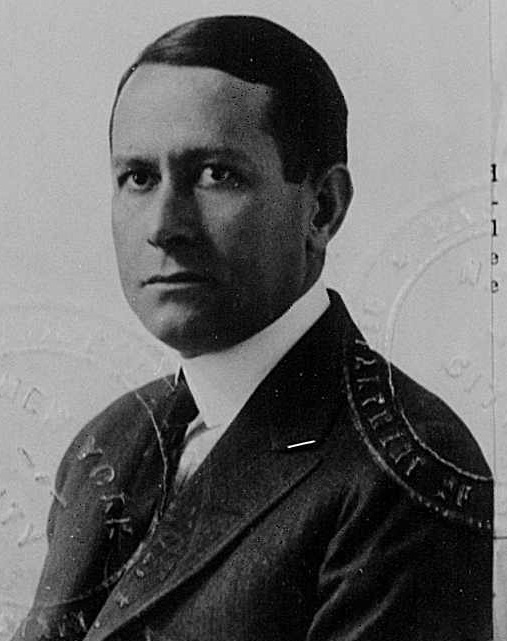 Water Works Deposito, Feb. 10th, 1899.
Water Works Deposito, Feb. 10th, 1899.To the Adjt. lst Nebr. U. S. Vol. Inf. Sir: I have the honor to make the following report of what occurred at Nebraska Outpost No. 2 on the evening of Febr. 4th, 1899. |

Outpost No. 2 of 1st Nebraska Regiment.
(Original Map provided by Historic San Mateo)
From this outpost [Outpost No. 2], about 100 yards down the road which passes it, is the town of Santol.
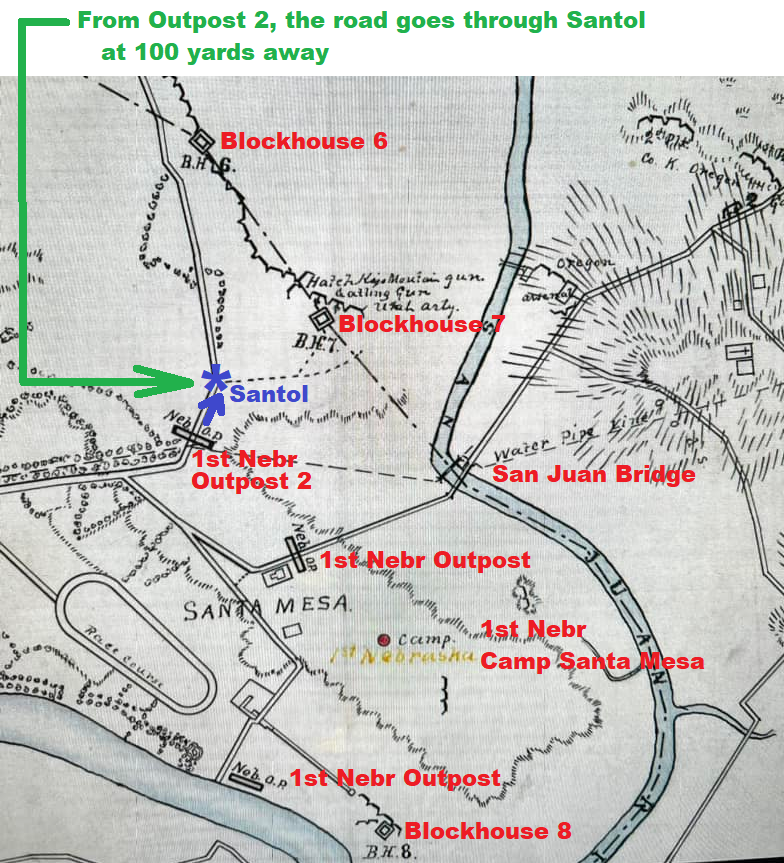
From Outpost 2, the road goes through Santol, at 100 yards away
(Original Map provided by Historic San Mateo)
Here we had a Cossack post of eight men stationed at this junction of three roads. One leading from Outpost No. 2, another leading to Blockhouse No. 7, the third to Blockhouse No. 6.

Cossack post at Santol, this junction of three roads
(Original Map provided by Historic San Mateo)
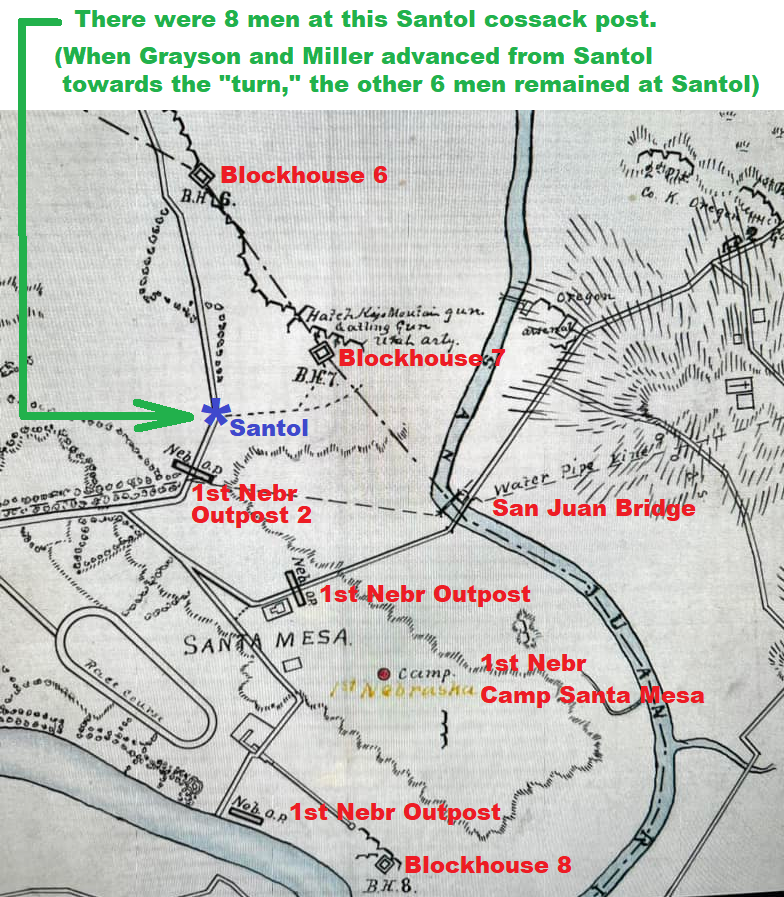
Cossack post at Santol, this junction of three roads
(Original Map provided by Historic San Mateo)
At 7:30 I instructed all the men of this post in their orders, a copy of which is hereto attached. They were to allow no armed insurgents to enter the town or the vicinity. They were to halt all armed persons who attempted to advance from the direction of the Insurgents' lines, which lay between Blockhouses 6 and 7 and the San Juan bridge, and order them back to their lines. If they refused to go, to arrest them if possible, or if this was impossible, to fire upon them.

Filipino lines, from Blockhouse 6 to Blockhouse 7 to San Juan Bridge
(Original Map provided by Historic San Mateo)
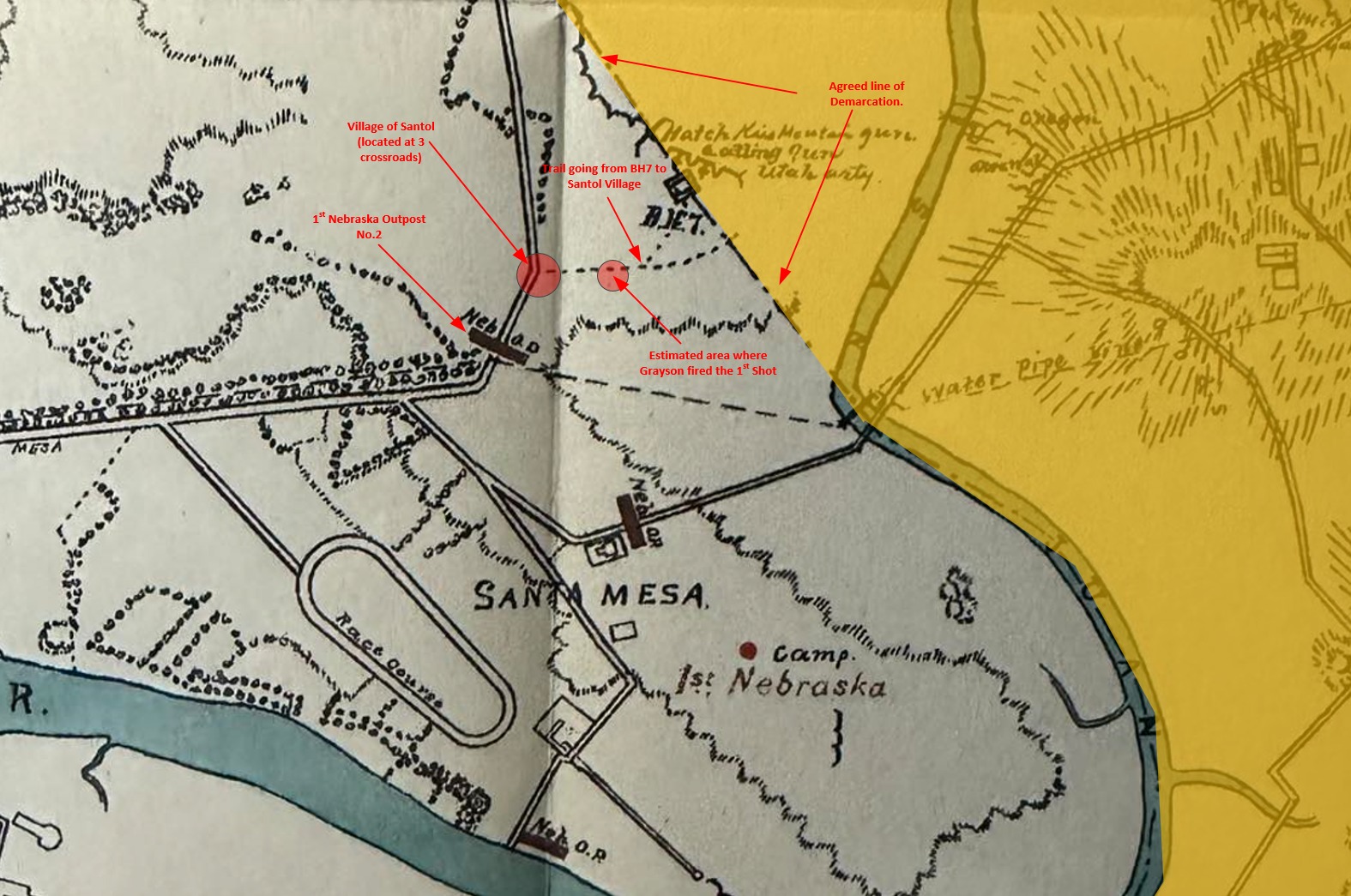
Filipino side (right side) of the demarcation line between Americans and Filipinos
(Map provided by Kevin Perez)
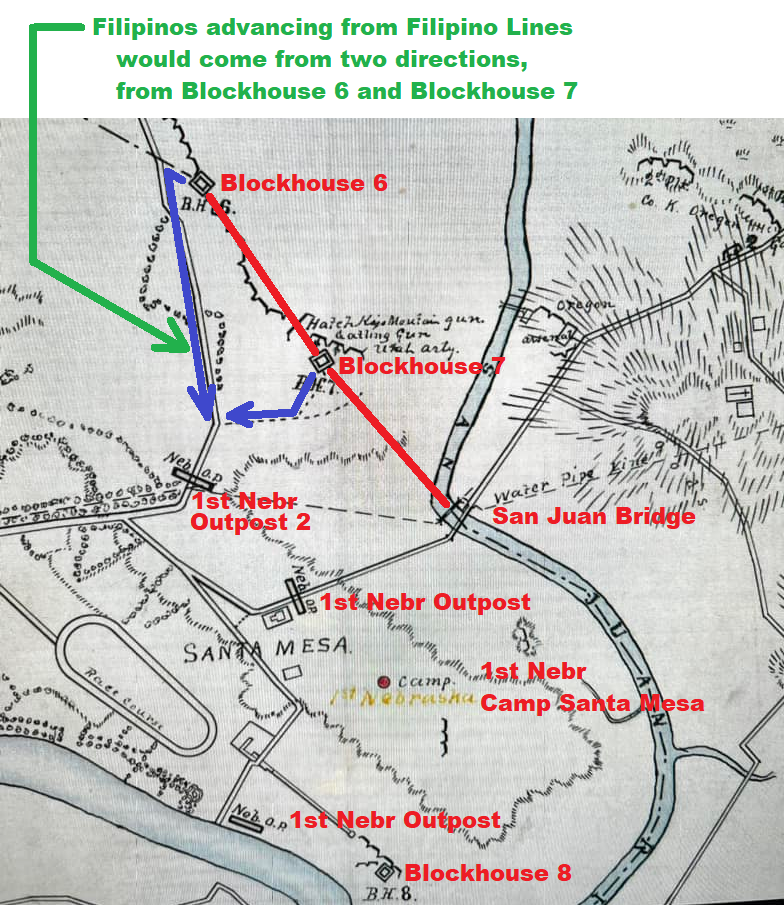
(Original Map provided by Historic San Mateo)
I also ordered them to patrol each of the roads leading to Blockhouses 6 And 7 for 100 yards, every half hour.
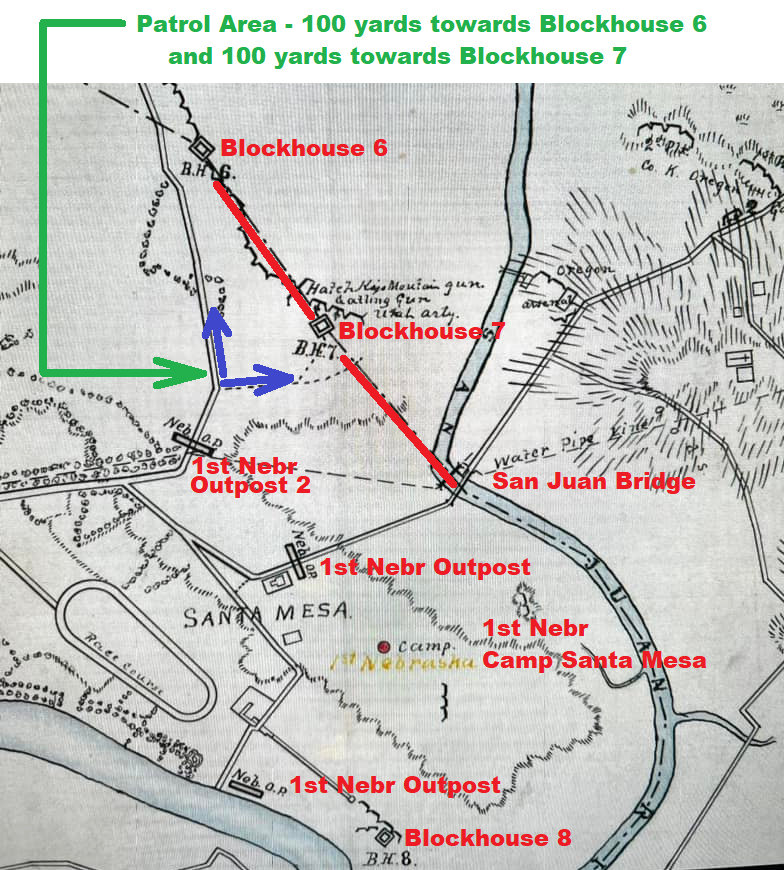
Patrol Area - 100 yards towards Blockhouse 6, and 100 yards towards Blockhouse 7.
(Original Map provided by Historic San Mateo)
Shortly before eight o'clock a patrol of three men advanced from Santol town side of the road and waited to see if there were any insurgents in the vicinity. Private Wm. Grayson, Co. "D," was a short distance in advance of the other two.
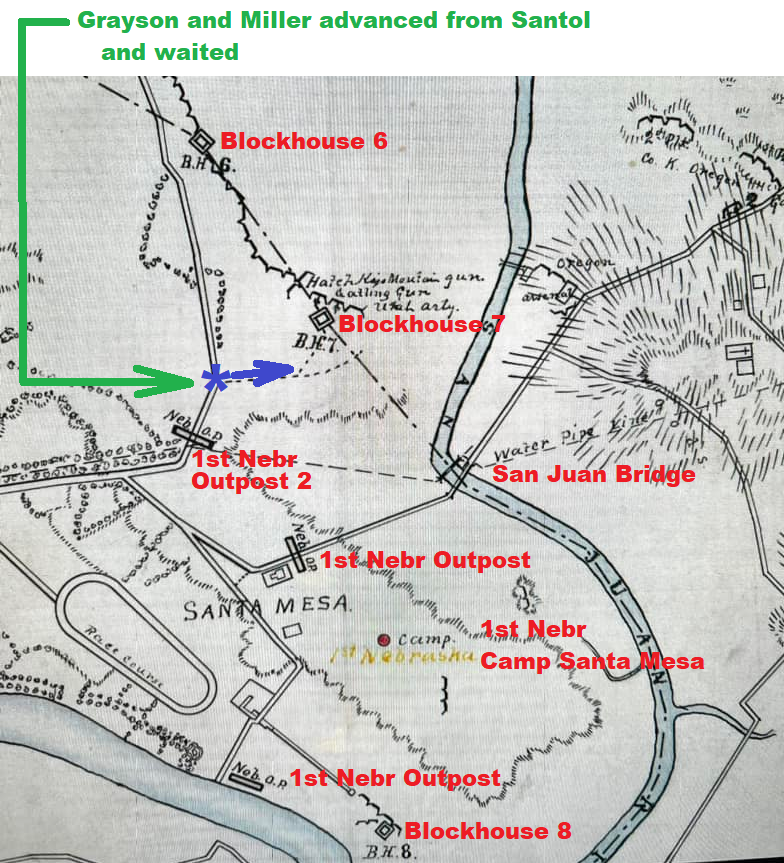
Grayson and Miller advanced from Santol and waited
(Original Map provided by Historic San Mateo)
After waiting about five minutes Private Grayson saw four armed men suddenly appear five yards in advance of him.
He immediately called "Halt," as did also Pvt. Miller, Co. "D," who was in rear of him and saw the men at the same time. At this command the four men cocked their pieces, whereupon Pvt. Grayson called "Halt" again, and fired at them.

Reenactment of Grayson's shot
Our three men then retreated to the town of Santol where I met them, being at the town when the shot was fired.
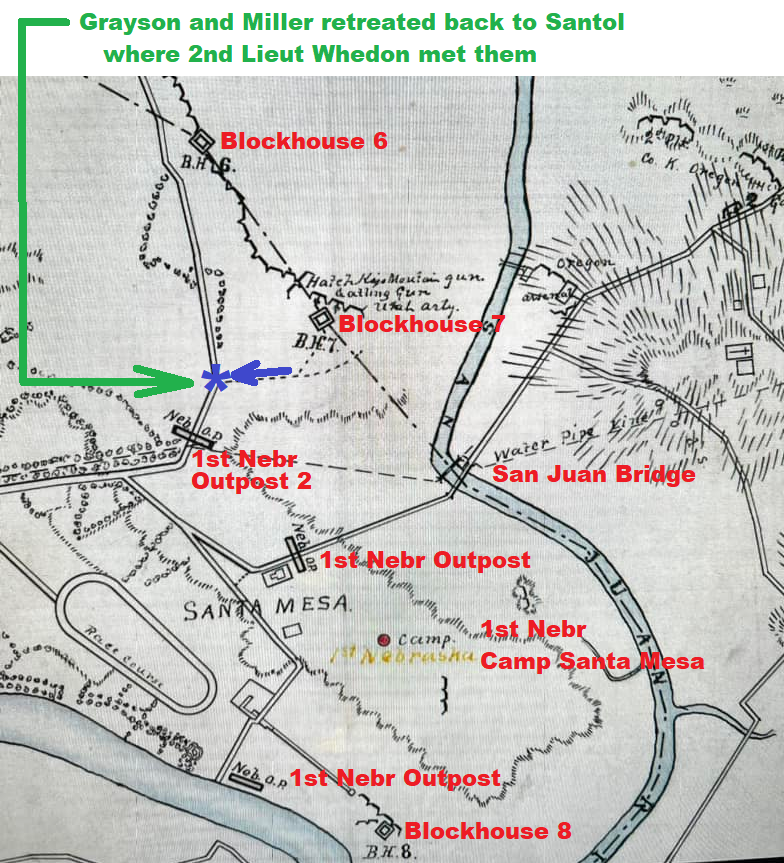
Grayson and Miller retreated back to Santol, where 2nd Lieut Whedon met them.
(Original Map provided by Historic San Mateo)
Immediately after the shot was fired we could hear the insurgents coming down the road from Blockhouse 7.
I sent a man back to the outpost to signal the Nebraska camp that the insurgents were coming from the blockhouse.
I remained with the men in Santol and in about three minutes from the time our man fired the shot several armed men emerged from the trees in our front across the road and the houses on our right and fired toward us where we were kneeling in the opposite side of the road. We returned their fire with a volley and
then fell back along the road to the pipe line, which lies near Outpost No. 2, the enemy keeping up a rapid fire along the road for about five minutes. We fired no more after leaving Santol until later in the evening.
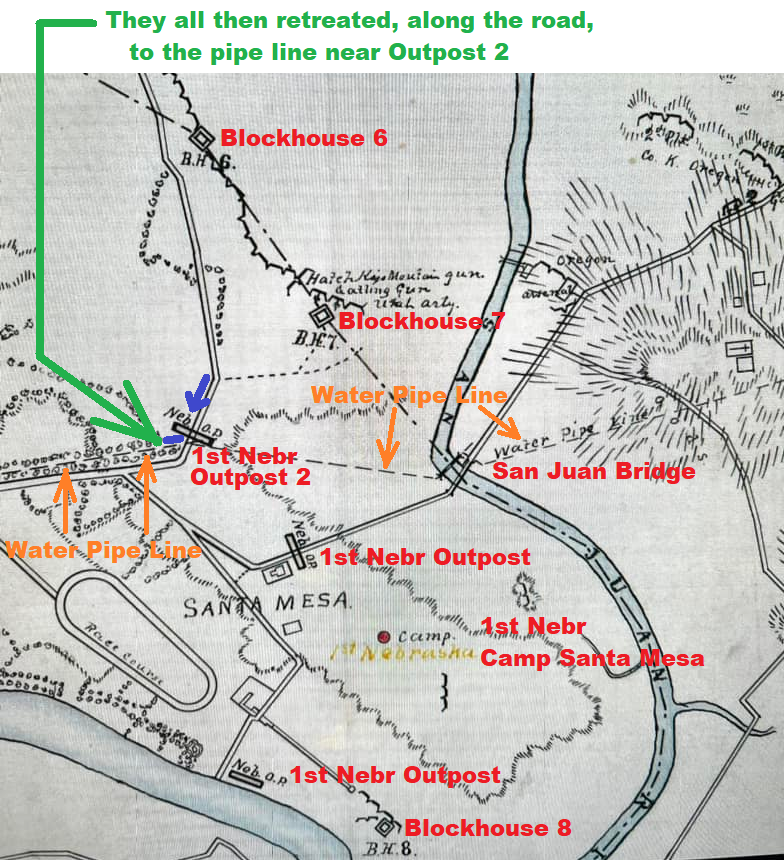
They then all retreated, along the road, to the pipe line near Outpost 2.
(Original Map provided by Historic San Mateo)
About ten minutes after the skirmish at Santol the insurgents opened up a general fire on the Nebraska camp and outposts and also on Colorado's outpost on our left.
On the morning of Febr. 4th, the insurgents ordered our men to move out of town Santol and upon their refusal to do so the former said that they would bring a body of men and drive them back when night came.
Very respectfully,
Your Obedient Servant,
(Signed) BURT D. WHEDON.,
2nd Lieut. Co. "C," 1st Nebr.
U. S. Vol. Inf.
-o-
| STATEMENT OF PVT WILLIAM W GRAYSON |
 "At 8 o'clock on the morning of February 4, I went on duty at outpost 2, which was about 100 yards from block house 7, at that time in the possession of the Filipinos and a half a mile from our headquarters in Santa Ana.
"At 8 o'clock on the morning of February 4, I went on duty at outpost 2, which was about 100 yards from block house 7, at that time in the possession of the Filipinos and a half a mile from our headquarters in Santa Ana.
Half an hour later our lieutenant and sergeant of the guard were reconnoitering along our line when several Filipinos, with a lieutenant, followed and called for a halt. They approached and began proclaiming that that was their territory. Our officers pretended not to understand their lingo and soon went on their way.
I was relieved at 10 o'clock and rested until 2 o'clock, but no demonstration had been made in the meantime.
All day the Filipinos were occasionally calling out vile names addressed to us Americans. They would vary this vith Spanish to the effect that 'One Filipino is equal to five Americans,' and 'Tonight we'll drive the Americans in a long way.' One of them had earlier called Stotsenberg the worst kind of a name, and it was only to avoid a conflict that the colonel did not yield to the temptation to clear every insurgent from our front. They had no business on that side of the river anyway.
"That night, about 8 o'clock, Miller and I — there were two of us -- were cautiously pacing our district. We came to a fence and were trying to see what the Filipinos were up to.
Suddenly, near at hand on our left, there was a low but unmistakable Filipino outpost signal whistle.
It was immediately answered by a similar whistle about twenty-five yards to the right.
Then the red lantern flashed its signal from blockhouse 7. We had never seen such a sign used before.
In a moment something rose slowly up, not twenty feet in front of us. It was a Filipino. They were evidently moving dangerously near.
"I yelled 'Halt!' and I made it pretty loud, for I was accustomed to challenging the officer of the guard in approved military style. The man moved. I challenged him with another loud 'Halt!' Then he impudently shouted 'Halto!' at me. Well, I thought the best thing to do was to shoot him. He dropped. If I didn't kill him, I guess he died of fright. Then two Filipinos sprang out of the gateway about fifteen feet from us. I called 'Halt!' and Miller fired and dropped one. I saw that another was left. Well, I think I got my second Filipino that time.

We retreated to where our six other fellows were, and I said: 'Line up, fellows, the "niggers" are in here all through these yards.'
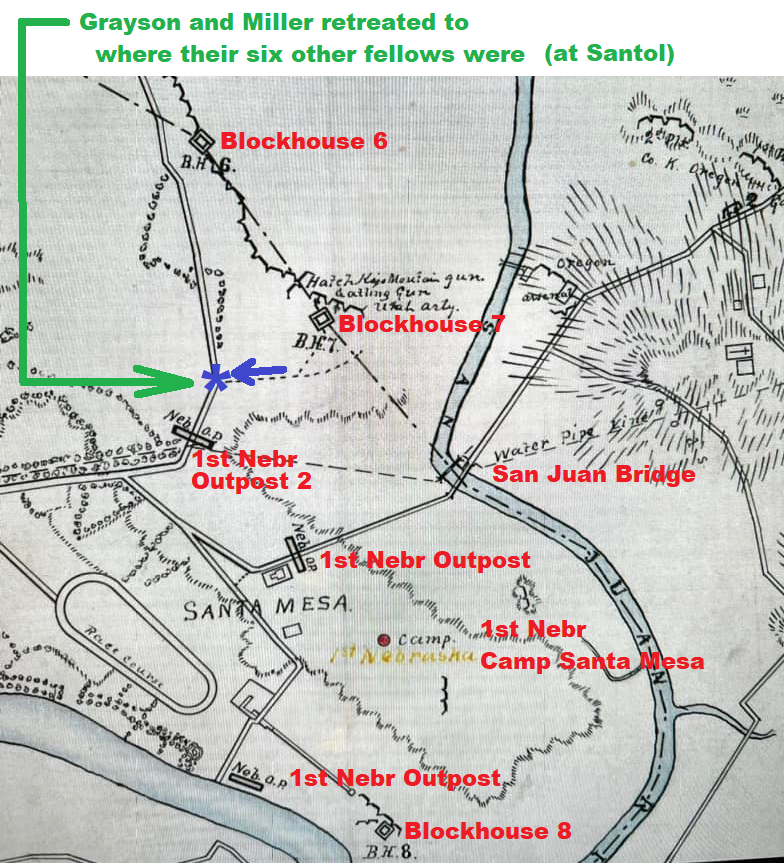
Grayson and Miller retreated to where their six other fellows were
(Original Map provided by Historic San Mateo)
such that when Grayson and Miller left Santol towards the "turn," the other 6 men remained at Santol,
and it was at Santol that Grayson/Miller returned to and rejoined the other 6 men who had remained there.

Cossack post at Santol, this junction of three roads
(Original Map provided by Historic San Mateo)
We then retreated to the pipe line and got behind the water main and stayed there all night.

They all then retreated to the pipe line
(Original Map provided by Historic San Mateo)
It was some minutes after our second shots before the Filipinos began firing, but then they made up for it by a fusillade that showed they had been prepared for their boasted advance."
-o-
| LETTER OF 2ND LIEUT BURT D WHEDON |


Lincoln (Nebraska) Courier, April 1, 1899
LIEUTENANT BURT WHEDON'S LETTER
In Camp near Water Works, 8 miles from Manila
February, 14th, 1899.
My Dear Father:
On Saturday night, February 4th, the Colonel detailed me to take charge of outpost No. 2 which is about a half mile to the left of our old camp at Santa Mesa, an outpost line of Spanish block houses which were at that time occupied by the insurgent forces. For quite a while the Filipinos had been threatening our outposts, attempting to drive them back, and doing everything in their power to harrass our men and bring on a fight without having to start it themselves. Our orders had been to avoid getting into a quarrel with them and we had taken insults and banterings which would have been quickly resented under ordinary conditions.
This letter of 2nd Lieut Whedon would follow the orientation of this map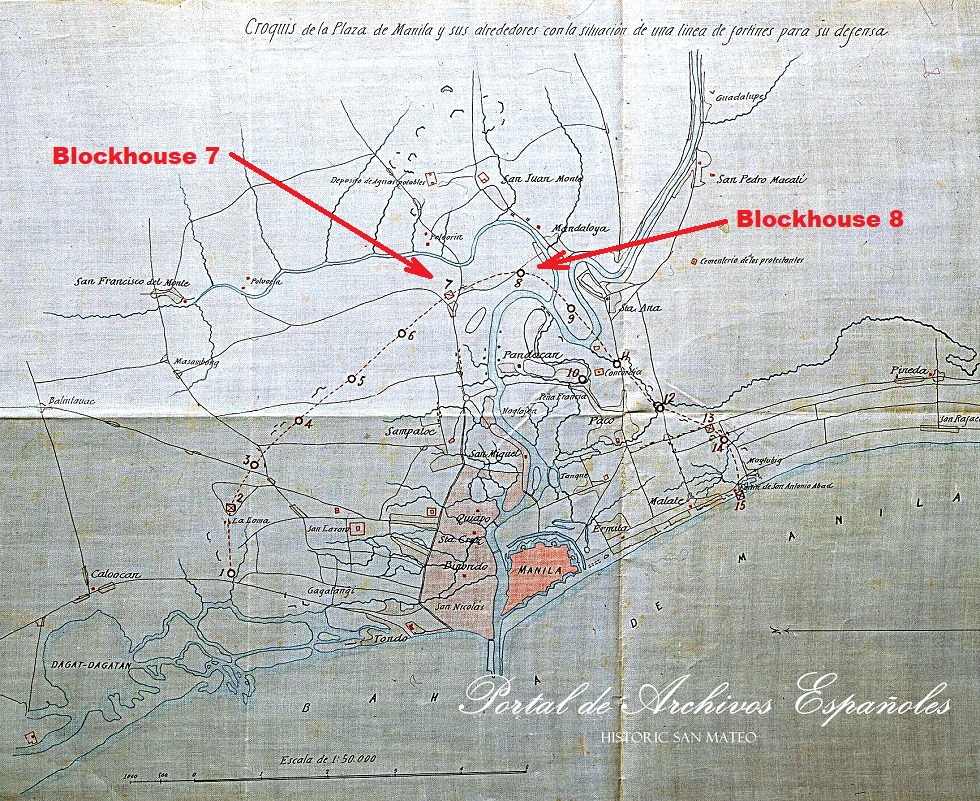 (Original Map provided by Historic San Mateo) |
Outpost 2 is to the left of Camp Santa Mesa.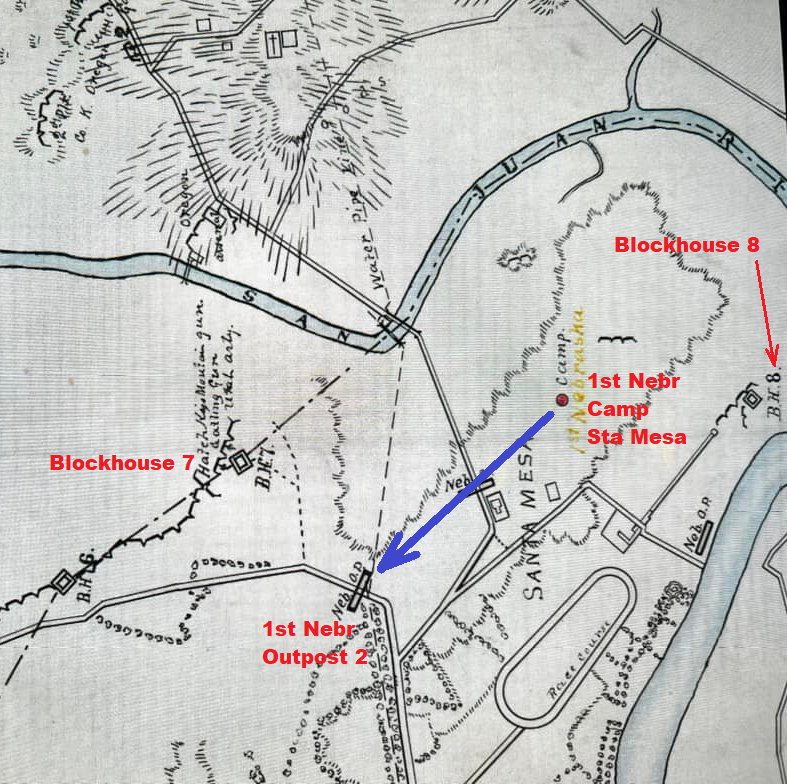 (Original Map provided by Historic San Mateo) |
On this particular day things had come to such a pass that the General decided we could stand no more of their impudence so he issued orders, and these were the orders he turned over to me, that any more insults to our outposts should be resented. That the Filipino soldiers must keep within the lines agreed upon between our authorities and theirs, and any who advanced beyond such a line should be arrested by our men, and if it was impossible to arrest them they should be driven back about one hundred yards from outpost No. 2.
|
Below: Filipino Lines (Green) - from Blockhouse 6 to Blockhouse 7 to San Juan Bridge (2nd Lieut Whedon had mentioned these Filipino lines in his report)  (Original Map provided by Historic San Mateo) |
Down the road to the left is the village of Santol.
Santol is to the left of Outpost 2. (Original Map provided by Historic San Mateo) |
Here we had a post of eight men stationed at the junction of three roads, one leading back to our outposts, another to block house 7, and the third to block house 6.
|
Here at Santol, on this junction of three roads, leading to Blockhouse 6, Blockhouse 7 and Outpost 2, a post of the 1st Nebr was in place. 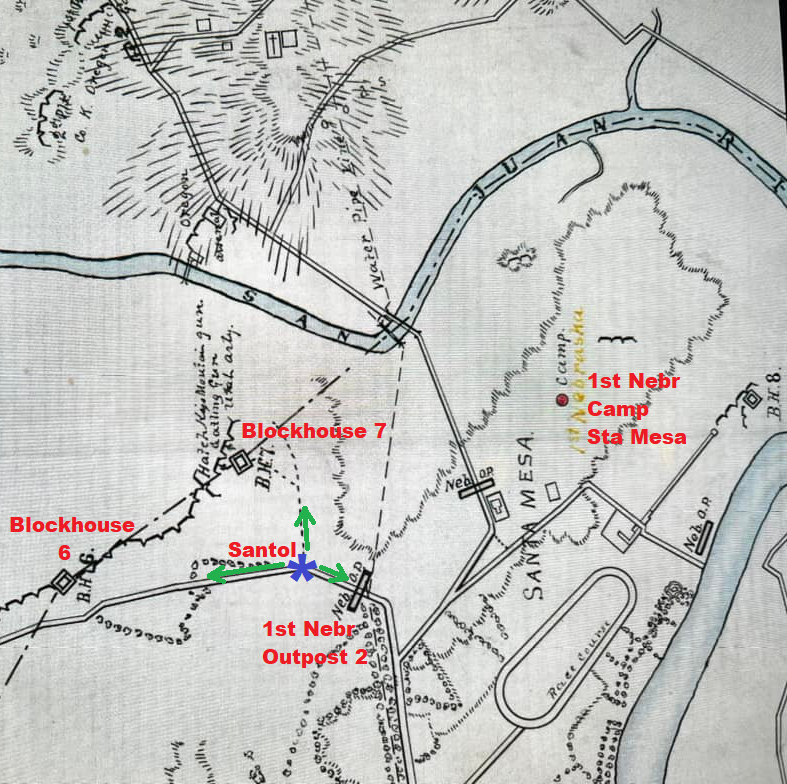 (Original Map provided by Historic San Mateo) |
These men had orders to patrol the roads to the block houses every half hour, to see that the insurgents did not advance from their lines.
Patrol Area (Blue) - Roads to Blockhouses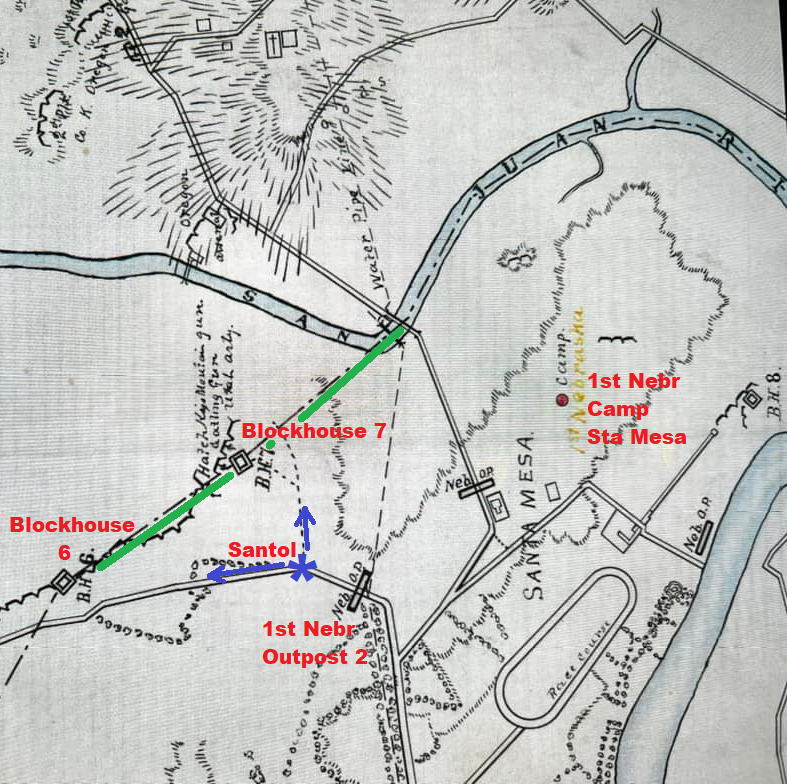 (Original Map provided by Historic San Mateo) |
About a quarter of eight I visited the post in Santol. A patrol of three men had started toward block house 7 about five minutes before; the other men were stationed in the middle of the cross road with fixed bayonets and loaded guns for they expected an attack that night. The sky was cloudy and the night as dark as pitch.
(Note: Grayson mentioned only two, he and Miller. These two, plus the six remaining at Santol, would equal the total of eight men at the Santol cossack post. Whedon must have been mistaken in adding a third man to Grayson and Miller.)
|
Grayson and Miller advanced from Santol towards Blockhouse 7 The others remained at Santol 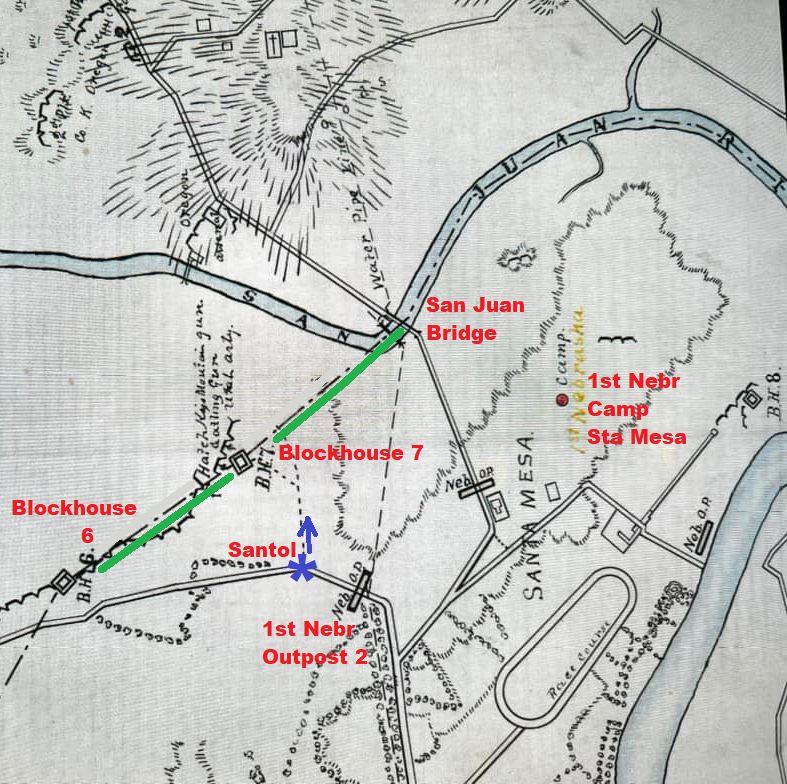 (Original Map provided by Historic San Mateo) |
I had reported instructions for this post and seeing that every thing was all right, was preparing to return to the outpost when suddenly, as the books say, "a shot rang out on the still night air." The men jumped into the shadow of the building and I ran up the road to the block house to see what was up.
About fifty yards up the road I met the three men of the patrol returning. The leader shouted as he passed me, "I shot the gentleman." Well, I knew "the stuff was off;" we could hear them coming down from the block house shouting and cursing, for our patrol had killed their man. I assembled the men in the shadow of a house along side of the road and went back to the outpost, had the guard signal to the camp, then returned to the post in the town. We were listening in the shadow at the edge of the road when suddenly several forms emerged from the bushes, stopping on the outside of the road not thirty feet away, and fired at us.
|
Grayson and Miller retreated back to Santol where they were met by 2nd Lieut Whedon 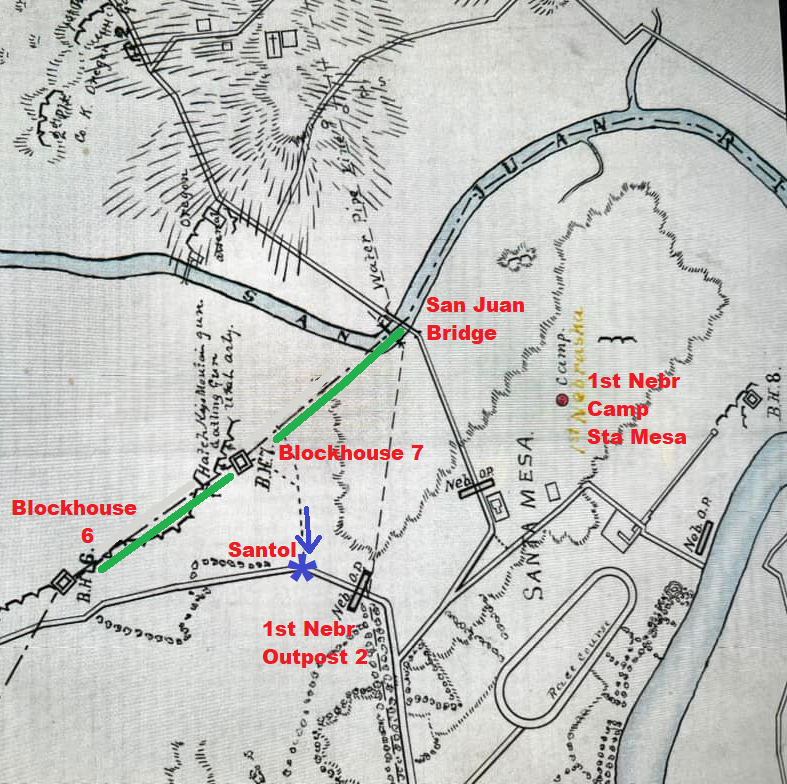 (Original Map provided by Historic San Mateo) |
We returned the fire with a volley and then seeing that they were coming from all directions, followed along the edge of the road to the pipe line, the insurgents keeping up a heavy fire upon us.
As I have written you before, the water supply for the city of Manila comes from a mountain stream about eight miles to the north from here. The water is pumped through a pipe about three feet in diameter which lies on the surface of the ground to a reservoir about four miles from the city where it again flows into another large pipe, also laid on top of the ground,
|
They all then retreated from Santol,
followed the road, to the Pipe Line near Outpost 2 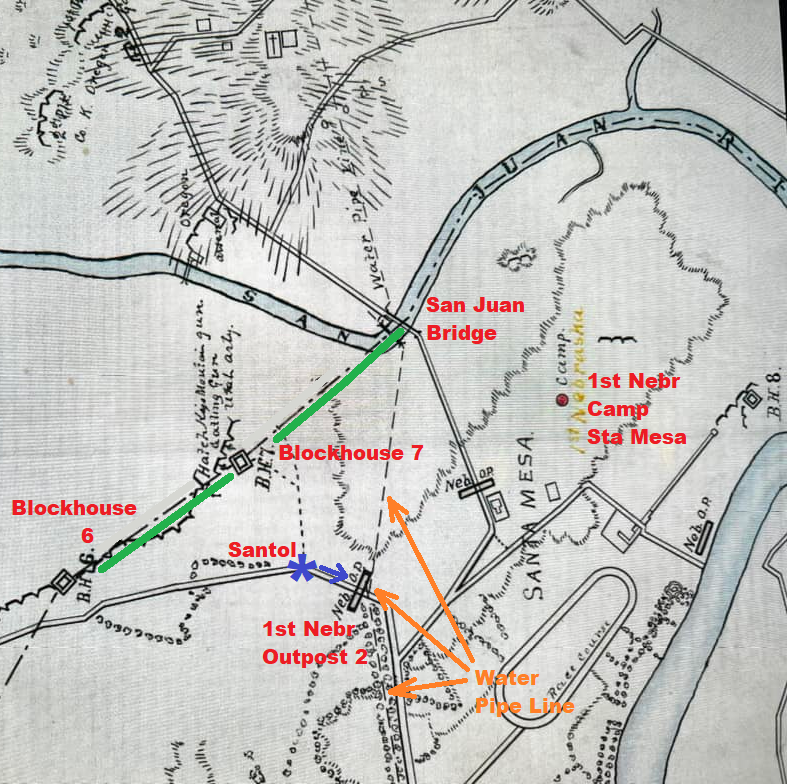 (Original Map provided by Historic San Mateo) |
| REPORT OF COL STOTSENBURG |
 First Nebraska, U. S. Volunteer Infantry.
First Nebraska, U. S. Volunteer Infantry.Office of Commanding Officer
February 6, 1899.
To the Adjt. General,
2nd. Division, 8th Army Corps.
(Through Military Channels.)
Sir:
I have the honor to report as follows respecting the action of the night of Feb. 4— and morning of Febr. 6th, 1899.
At about halt past eight p. m. the guard in the village of Santol about 200 yards southwest of Blockhouse No. 7 challenged four armed Philippinos and ordered them to halt.
Instead of doing so the Philippino patrol cocked their pieces. The sentinel challenged again and then as the natives did not halt but continued the advance, he fired.
This was immediately replied to from Blockhouse No. 7, and in about fifteen minutes fire was opened on our camp.
By this time we occupied the line of battle as previously arranged. Twelve men under First Sgt. Curtis of "C" Company were placed on a knoll east of camp to prevent crossing the river. Though a gallant fight was made here, it was impossible to prevent the crossing on the advance of the Philippinos, who were secreted in village west of the San Juan. Seeing that the camp was surrounded, I moved Company "L," Capt. Taylor, and "M," Capt. Wilson, back from the pipe line to the south of camp. Afterwards I sent for Company "E" under Lt. Naracong and asked for reinforcements, as our lines were too long. Here these Companies (L, M & E) did most gallant work. penetrating the village and driving the men out of the convent. The Utah artillery, Lieut. Webb' platoon, were stationed at McLeod's house and went into action in the morning at daybreak, doing great execution, silencing the guns and driving hack the enemy from the bridge, the powder magazine, blockhouse and the convent. The work of this platoon and the one under Lieut. Gibbs, with the Nordenfeldt guns at the bridge was very fine.
Our line had, previously, advanced taking Blockhouses 6 and 7, where a great many Philippinos were killed, by the splendid work of Companies "K," Capt. Kilian, and "D," Capt. Harpolsheimer. I then ordered the line to make a half turn to the right, where we could flank the powder magazine and roads. In the meantime "B" Company under Lieut. Wadsworth, "G" Company, Capt. Forby, and "H' Company, Capt. Eager, protected the advance of Company "F," commanded by Lieut. Gegner, across the San Juan river bridge. This work was executed with the coolness and precision of drill and Major Mulford's entire battalion followed and cleaned the powder magazine. After this charge the center of their line was broken. Although they fired on us and the Tennessee from the huts and bamboo, which was very galling.
We made a last charge up the San Juan del Monte hill and put the whole of their forces to flight. We occupied this place and raised our flag. They still did some firing from the bamboos and huts on our men and I ordered Co. "I" under Lieut. Smith to occupy the eastern end of the wall of the Deposito and drive them off. This he did with the loss of one man.
Every man in this regiment rendered magnificent service. Besides the companies mentioned, "C" Company, Capt. Hollingsworth, fought hard during the night.
The battalion of two companies of Colorado under command of Major Grove did excellent work and timely service, especially In the village southeast of camp I enclose a copy of their report. Also one of the officer in charge of the outpost where the first shot was fired, as well as copies of his orders, which he seems to have carried out.
The gunboat lent valuable assistance and seemed to be effective. Supplies were forwarded promptly and without friction. Medical attention excellent.
After we had occupied this place and were preparing for anything further Gen. Hale arrived and took command.
Enclosures: Copies of orders and copy of list of casualties. Copy of report of officer at Outpost No. 2.
Very respectfully,
(Signed) JOHN M. STOTSENBURG,
Col. 1st Nebr., U. S. Vol. Inf.
-o-
| FILIPINO ACCOUNTS OF THE FIRST SHOT |
Who really started the Filipino-American war?
by Virgilio C Leynes
| SOURCES |
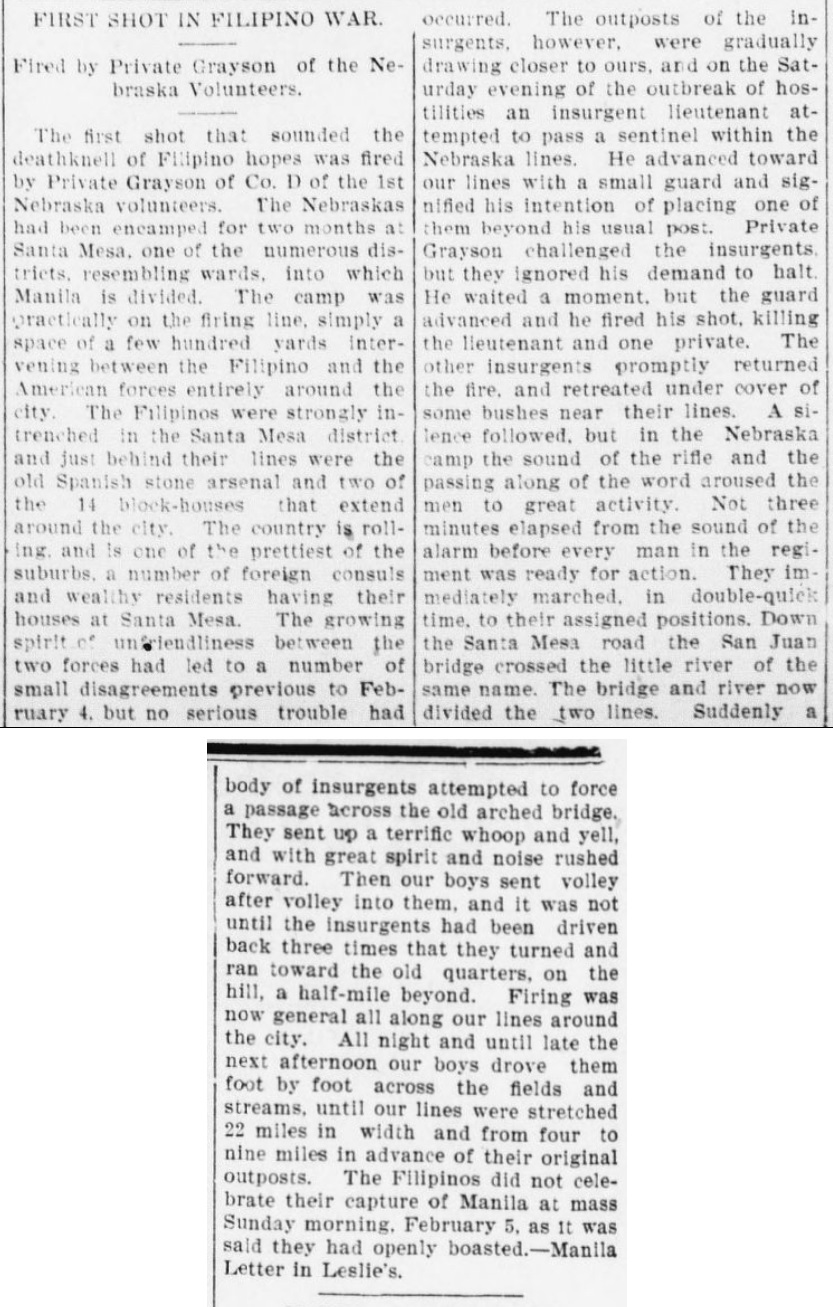
Iowa County democrat. [volume], June 29, 1899
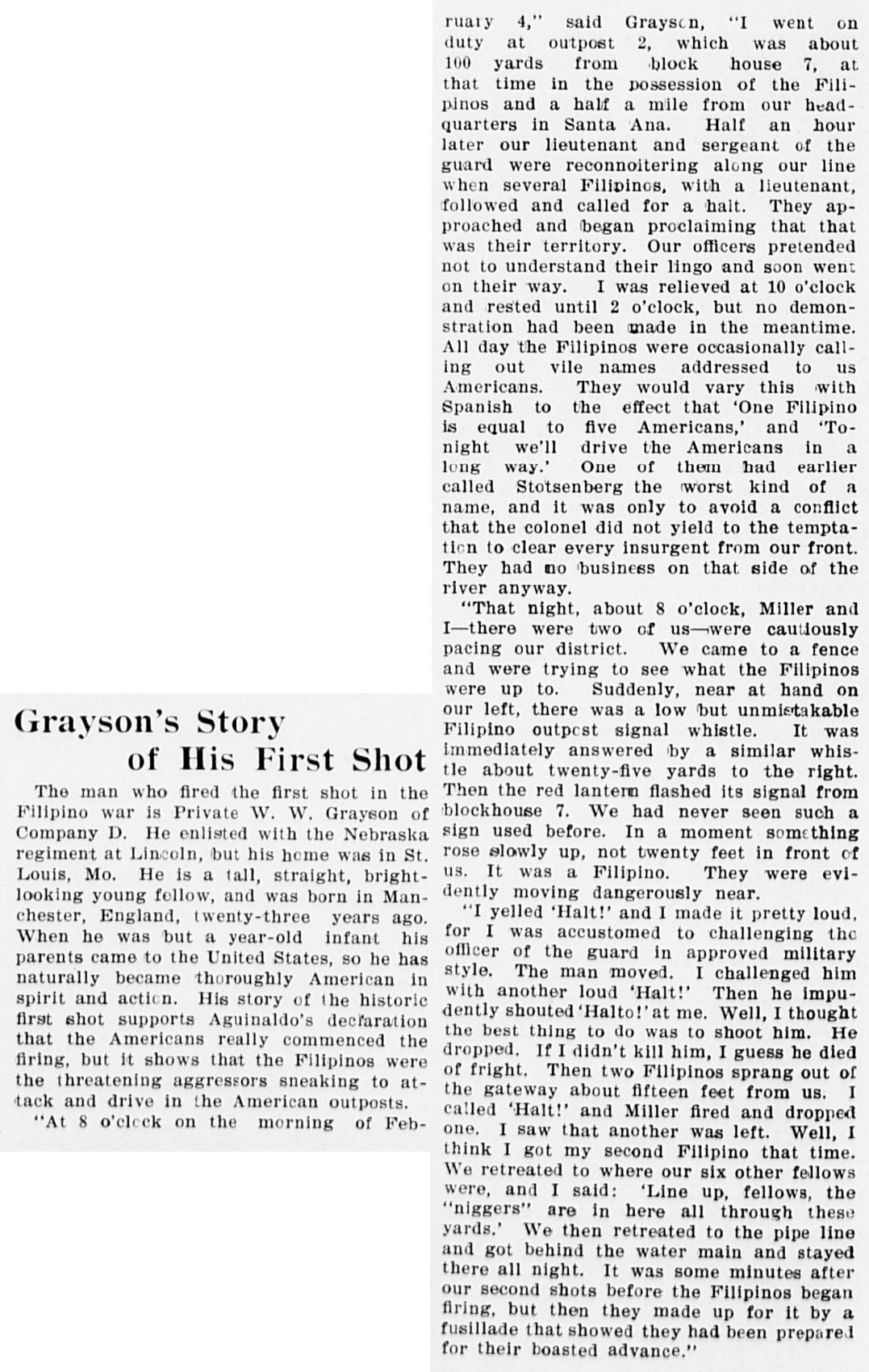
Omaha Daily Bee, Aug 6, 1899
Grayson's Story of His First Shot
The man who fired the first shot in the Filipino war is Private W. W. Grayson of Company D. He enlisted with the Nebraska regiment at Lincoln, but his home was in St. Louis, Mo. He is a tall, straight, bright-looking young fellow, and was born in Manchester, England, twenty-three years ago. When he was but a year-old infant his parents came to the United States, so he has naturally became thoroughly American in spirit and action. His story of the historic first shot supports Aguinaldo's decraration that the Americans really commenced the firing, but it shows that the Filipinos were the threatening aggressors sneaking to attack and drive in the American outposts.
"At 8 o'clock on the morning of February 4," said Grayson, "I went on duty at outpost 2, which was about 100 yards from block house 7, at that time in the possession of the Filipinos and a half a mile from our headquarters in Santa Ana. Half an hour later our lieutenant and sergeant of the guard were reconnoitering along our line when several Filipinos, with a lieutenant, followed and called for a halt. They approached and began proclaiming that that was their territory. Our officers pretended not to understand their lingo and soon went on their way. I was relieved at 10 o'clock and rested until 2 o'clock, but no demonstration had been made in the meantime. All day the Filipinos were occasionally calling out vile names addressed to us Americans. They would vary this vith Spanish to the effect that 'One Filipino is equal to five Americans,' and 'Tonight we'll drive the Americans in a long way.' One of them had earlier called Stotsenberg the worst kind of a name, and it was only to avoid a conflict that the colonel did not yield to the temptation to clear every insurgent from our front. They had no business on that side of the river anyway.
"That night, about 8 o'clock, Miller and I — there were two of us -- were cautiously pacing our district. We came to a fence and were trying to see what the Filipinos were up to. Suddenly, near at hand on our left, there was a low but unmistakable Filipino outpost signal whistle. It was immediately answered by a similar whistle about twenty-five yards to the right. Then the red lantern flashed its signal from blockhouse 7. We had never seen such a sign used before. In a moment something rose slowly up, not twenty feet in front of us. It was a Filipino. They were evidently moving dangerously near.
"I yelled 'Halt!' and I made it pretty loud, for I was accustomed to challenging the officer of the guard in approved military style. The man moved. I challenged him with another loud 'Halt!' Then he impudently shouted 'Halto!' at me. Well, I thought the best thing to do was to shoot him. He dropped. If I didn't kill him, I guess he died of fright. Then two Filipinos sprang out of the gateway about fifteen feet from us. I called 'Halt!' and Miller fired and dropped one. I saw that another was left. Well, I think I got my second Filipino that time. We retreated to where our six other fellows were, and I said: 'Line up, fellows, the "niggers" are in here all through these yards.' We then retreated to the pipe line and got behind the water main and stayed there all night. It was some minutes after our second shots before the Filipinos began firing, but then they made up for it by a fusillade that showed they had been prepared for their boasted advance."
-o-

Omaha Daily Bee, August 30, 1899

Image from: Geospatial Analysis of the First Shot of the Philippine-American War
Ariel C. Blanco, Rene R. Escalante, Emmanuel N. Encarnacion
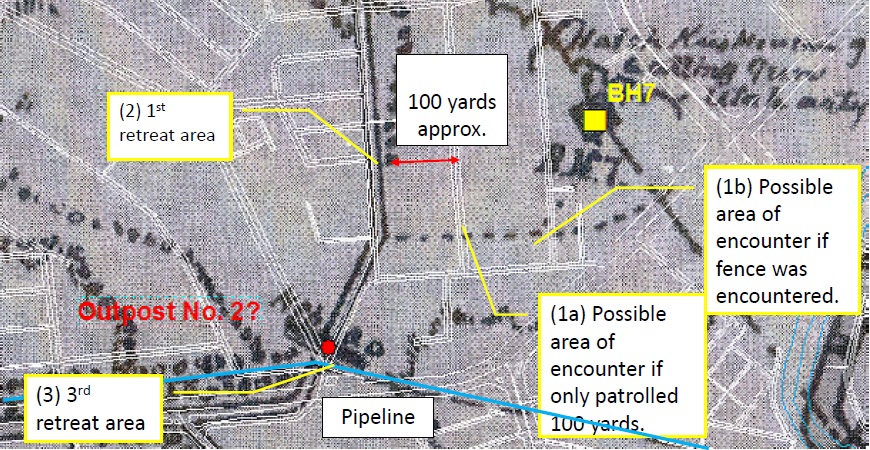
Image from: Geospatial Analysis of the First Shot of the Philippine-American War
Ariel C. Blanco, Rene R. Escalante, Emmanuel N. Encarnacion
